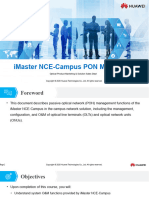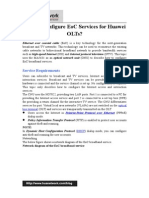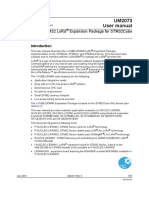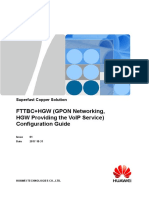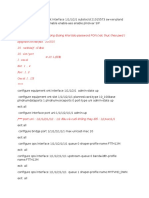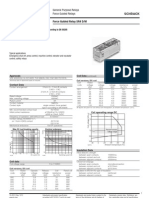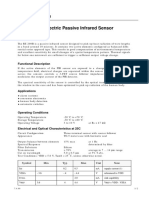Smart Grid GPON SolutionConfiguration Guide
Uploaded by
luisSmart Grid GPON SolutionConfiguration Guide
Uploaded by
luisSmart Grid GPON Solution
Configuration Guide
Issue 01
Date 2021-07-30
HUAWEI TECHNOLOGIES CO., LTD.
Copyright © Huawei Technologies Co., Ltd. 2021. All rights reserved.
No part of this document may be reproduced or transmitted in any form or by any means without prior
written consent of Huawei Technologies Co., Ltd.
Trademarks and Permissions
and other Huawei trademarks are trademarks of Huawei Technologies Co., Ltd.
All other trademarks and trade names mentioned in this document are the property of their respective
holders.
Notice
The purchased products, services and features are stipulated by the contract made between Huawei and
the customer. All or part of the products, services and features described in this document may not be
within the purchase scope or the usage scope. Unless otherwise specified in the contract, all statements,
information, and recommendations in this document are provided "AS IS" without warranties, guarantees or
representations of any kind, either express or implied.
The information in this document is subject to change without notice. Every effort has been made in the
preparation of this document to ensure accuracy of the contents, but all statements, information, and
recommendations in this document do not constitute a warranty of any kind, express or implied.
Huawei Technologies Co., Ltd.
Address: Huawei Industrial Base
Bantian, Longgang
Shenzhen 518129
People's Republic of China
Website: https://www.huawei.com
Email: support@huawei.com
Issue 01 (2021-07-30) Copyright © Huawei Technologies Co., Ltd. i
Configuration Guide Contents
Contents
1 Configuration Example of Transmitting Video Monitoring Data, Intelligently
Collecting Power Consumption Information over Ethernet Access ...................................... 1
2 Configuration Example of Automatically Transmitting Site Information over Ethernet
(Single-Homing) ............................................................................................................................. 10
3 Configuration Example of Automatically Transmitting Site Information over Ethernet
(Dual-Homing) ............................................................................................................................... 21
4 Configuration Example of Intelligently Collecting Power Consumption Information
over a Serial Port ............................................................................................................................ 33
Issue 01 (2021-07-30) Copyright © Huawei Technologies Co., Ltd. ii
1 Configuration Example of Transmitting Video
Monitoring Data, Intelligently Collecting Power
Configuration Guide Consumption Information over Ethernet Access
1 Configuration Example of Transmitting
Video Monitoring Data, Intelligently
Collecting Power Consumption Information
over Ethernet Access
An ONU can access services through a GE/FE auto-adaptive electrical port and transmit data
upstream to an OLT through a GPON port. The OLT then forwards data to the upper-layer
device. In this way, video surveillance data can be transmitted, and power consumption
information can be collected intelligently. All OLT commands described in this document use
V100R020C10 as examples. Commands may be slightly different in versions. For detailed
commands, see the Command Reference of the corresponding version.
Service Requirements
Video detecting data,
To enhance area security, a video detecting point is deployed and detected in real time at
the monitoring center.
The video encoder at this detecting point provides Ethernet access so an ONU can
receive video detecting data over Ethernet.
Optional: Data is transmitted over a GPON network.
Intelligently collecting power consumption information,
In an electrical power system, a large amount of meter data needs to be collected in
centralized mode in real time and sent to an automatic meter reading system (AMR)
server for monitoring and processing.
The smart meter on the user side has a serial port and an ONU is connected to the smart
meter through the serial port.
Data is transmitted over a GPON network.
Networking
Video detecting data,
Figure 1-1 shows an example network for configuring video monitoring data transmission
over Ethernet
Issue 01 (2021-07-30) Copyright © Huawei Technologies Co., Ltd. 1
1 Configuration Example of Transmitting Video
Monitoring Data, Intelligently Collecting Power
Configuration Guide Consumption Information over Ethernet Access
Located at a detected point, the ONU is connected to video encoders through GE/FE
autonegotiation electrical ports. The ONU receives encoded video detecting information
and forwards the information upstream to an OLT at the monitoring center.
The OLT forwards the information to other detecting devices at the monitoring center.
Figure 1-1 Example network for configuring video monitoring data transmission over Ethernet
Intelligently collecting power consumption information,
Figure 1-2 shows an example network for configuring intelligent collection of power
consumption information in the electrical power system over Ethernet
The ONU is connected to a concentrator through a GE/FE autonegotiation electrical port.
The concentrator is connected to a collector using power cables and sends the power
consumption information collected by the collector to the ONU.
The ONU forwards the power consumption information to an OLT and the OLT forwards
the information to the upper-layer device. Then the upper-layer device forwards the
information to an AMR server.
Issue 01 (2021-07-30) Copyright © Huawei Technologies Co., Ltd. 2
1 Configuration Example of Transmitting Video
Monitoring Data, Intelligently Collecting Power
Configuration Guide Consumption Information over Ethernet Access
Figure 1-2 Example network for configuring intelligent collection of power consumption
information in the electrical power system over Ethernet
Configuration Flowchart
Figure 1-3 provides the procedure for configuring video detecting data, power consumption
information transmission over Ethernet.
Figure 1-3 Procedure for configuring video detecting data, power consumption information
transmission over Ethernet.
Device Step Configuration Description
Issue 01 (2021-07-30) Copyright © Huawei Technologies Co., Ltd. 3
1 Configuration Example of Transmitting Video
Monitoring Data, Intelligently Collecting Power
Configuration Guide Consumption Information over Ethernet Access
Device Step Configuration Description
OLT 1. Add an ONU to the OLT. An ONU can be configured only after
it is successfully added to an OLT.
2. Configure the service The video surveillance data and meter
channel between the OLT data collected by the ONU need to be
and the ONU. transparently transmitted to the
upper-layer network through the OLT,
and then transmitted to the monitoring
center and meter reading server.
ONU - No configuration is required on the
ONU. The service channel is issued by
the OLT.
Data Plan
Table 1-1 describes the data plan for the OLT, and Table 1-2 describes the data plan for the
ONU.
Table 1-1 Data planning for video surveillance data transmission and intelligent power
consumption information collection on the OLT Side
Configuration Item Data
Upstream port Port : 0/19/0
VLAN CVLAN 100, SVLAN 100, type: Smart
GPON service board Port: 0/3/1
ONU ID: 1
ONU authentication mode: SN
ONU SN: 48575443E6D8B541
DBA profile Profile ID: 10
Type: type3
Assured bandwidth: 20 Mbit/s
Maximum bandwidth: 50 Mbit/s
ONU line profile Profile ID: 10, bound to DBA profile 10
GEM Port ID: 1
T-CONT ID: 5
ONU service profile Profile ID: 10
Upstream VLAN: VLAN 100 of the Smart type
Number of ETH ports: auto-adaptive
User-side VLAN: VLAN 2. The type is Smart (video
surveillance data transmission) or untagged (intelligent
collection of power consumption information).
Issue 01 (2021-07-30) Copyright © Huawei Technologies Co., Ltd. 4
1 Configuration Example of Transmitting Video
Monitoring Data, Intelligently Collecting Power
Configuration Guide Consumption Information over Ethernet Access
Configuration Item Data
ONU management OMCI
mode
Table 1-2 Data planning for video surveillance data transmission on the ONU side
Configuration Data Remarks
Item
Upstream port PON port 1 PON1 is a BOB port and
does not require an optical
module.
Service port GE 1 port -
Upstream VLAN VLAN 100 of the Smart type The upstream VLAN must
be the same as the C-VLAN
of the OLT.
C-VLAN VLAN 2 of the Smart type (used for -
transmitting video surveillance data)
untagged (used for intelligent
collection of power consumption
information)
Procedure
Step 1 Configurations on the OLT side:
1. Create an S-VLAN and add an upstream port to it.
Create smart S-VLAN 100 and add upstream port 0/19/0 to it.
huawei(config)#vlan 100 smart
huawei(config)#port vlan 100 0/19 0
2. (Optional) Configure upstream link aggregation.
In this example, a single upstream port is used. In the case of multiple upstream ports,
upstream link aggregation can be configured.
3. Configure a GPON ONU profile.
GPON ONU profiles include the DBA profile, line profile, service profile, and alarm
profile.
− DBA profile: A DBA profile describes GPON traffic parameters. A T-CONT is
bound to a DBA profile for dynamic bandwidth allocation, improving upstream
bandwidth usage.
− Line profile: A line profile describes the binding between the T-CONT and the DBA
profile, the QoS mode of the service port, and the mapping between the GEM port
and the ONU-side service.
− Service profile: A service profile provides the service configuration channel for the
ONU that is managed by using optical network terminal management and control
interface (OMCI).
Issue 01 (2021-07-30) Copyright © Huawei Technologies Co., Ltd. 5
1 Configuration Example of Transmitting Video
Monitoring Data, Intelligently Collecting Power
Configuration Guide Consumption Information over Ethernet Access
− Alarm profile: An alarm profile contains a series of alarm thresholds to measure and
monitor the performance of activated ONU lines. When a statistical value reaches
the threshold, the host is notified and an alarm is reported to the log host and the
NMS.
a. Configure a DBA profile.
To query existing DBA profiles in the system, run the display dba-profile
command. If existing DBA profiles in the system do not meet the requirement, run
the dba-profile add command to create a DBA profile.
Set the profile ID to 10, type to Type3, assured bandwidth to 20 Mbit/s, and
maximum bandwidth to 50 Mbit/s.
huawei(config)#dba-profile add profile-id 10 type3 assure 20480 max 51200
b. Configure an ONU line profile.
Add a GPON ONU line profile with index 10 and bind T-CONT 5 to DBA profile
10. In this way, the T-CONT provides flexible DBA solutions based on different
configurations in the DBA profile.
huawei(config)#ont-lineprofile gpon profile-id 10
huawei(config-gpon-lineprofile-10)#tcont 5 dba-profile-id 10
GEM port 1 is used to carry the video surveillance service. GEM port 1 is bound to
T-CONT 5. Set the QoS mode to priority-queue (default) and the queue priority to
3.
huawei(config-gpon-lineprofile-10)#gem add 1 eth tcont 5 priority-queue 3
Set the mapping mode between the GEM port and the ONU-side service to VLAN
(default) to map the service port of the video surveillance service of VLAN 100 to
GEM port 1.
huawei(config-gpon-lineprofile-10)#mapping-mode vlan
huawei(config-gpon-lineprofile-10)#gem mapping 1 1 vlan 100
After the configuration is completed, run the commit command to make the
configured parameters take effect.
huawei(config-gpon-lineprofile-10)#commit
huawei(config-gpon-lineprofile-10)#quit
iii. Configure an ONU service profile.
Service profile for video surveillance data transmission
Set the profile ID to 10, the number of Ethernet ports on the ONU to adaptive, the
upstream VLAN of the ONU to 100, and the VLAN of user-side GE1 to 2.
huawei(config)#ont-srvprofile gpon profile-id 10
huawei(config-gpon-srvprofile-10)#ont-port eth adaptive
huawei(config-gpon-srvprofile-10)#port vlan eth 1 translation 100
user-vlan 2
huawei(config-gpon-srvprofile-10)#commit
Service profile for intelligent collection of power consumption information
Set the profile ID to 10, the number of Ethernet ports on the ONU to adaptive, the
upstream VLAN of the ONU to 100, and the VLAN of user-side GE1 to untagged.
huawei(config)#ont-srvprofile gpon profile-id 10
huawei(config-gpon-srvprofile-10)#ont-port eth adaptive
huawei(config-gpon-srvprofile-10)#port vlan eth 1 100
huawei(config-gpon-srvprofile-10)#commit
c. (Optional) Configure an alarm threshold profile.
Issue 01 (2021-07-30) Copyright © Huawei Technologies Co., Ltd. 6
1 Configuration Example of Transmitting Video
Monitoring Data, Intelligently Collecting Power
Configuration Guide Consumption Information over Ethernet Access
The ID of the default GPON alarm threshold profile is 1. The thresholds of all
the alarm parameters in the default alarm profile are 0, which indicates that no
alarm is reported.
In this example, the default alarm threshold profile is used and does not need
to be configured.
To configure alarm threshold parameters for monitoring the performance
statistics of an activated ONU line, run the gpon alarm-profile add command
to configure a GPON alarm threshold profile.
4. Add an ONU to the OLT.
Connect an ONU to the GPON port of the OLT using a fiber. Services can be configured
only after an ONU is successfully added to the OLT.
a. Add an ONU.
The ONU is connected to GPON port 0/3/1 through a splitter. The ONU ID is 1, the
SN is 48575443E6D8B541, the management mode is OMCI, the ID of the bound
line profile is 10, and the ID of the bound service profile is 10.
An ONU can be added in two modes. Select either mode as required.
Add an ONU offline: If the password or SN of an ONU is obtained, you can
run the ont add command to add the ONU offline.
Automatically find an ONU: If the password or SN of an ONU is unknown,
run the port ont-auto-find command in GPON mode to enable the ONU
auto-find function of the GPON port. Then, run the ont confirm command to
confirm the ONU after it is automatically discovered.
Run the following command to add an ONU in offline mode:
huawei(config)#interface gpon 0/3
huawei(config-if-gpon-0/3)#ont add 1 1 sn-auth 48575443E6D8B541 omci
ont-lineprofile-id 10 ont-srvprofile-id 10 desc MA5621E_0/3/1/1
Run the following commands to add ONUs in the auto-find mode:
huawei(config)#interface gpon 0/3
huawei(config-if-gpon-0/3)#port 1 ont-auto-find enable
huawei(config-if-gpon-0/3)#display ont autofind 1
//After this command is executed, the information about all ONUs connected
to the GPON port through a splitter is displayed.
huawei(config-if-gpon-0/3)#ont confirm 1 ontid 1 sn-auth 48575443E6D8B541 omci
ont-lineprofile-id 10 ont-srvprofile-id 10 desc MA5621E_0/3/1/1
If multiple ONUs of the same type bound to the same line profile or service profile are connected to the
same port, you can add the ONUs in bulk by confirming automatically discovered ONUs in bulk to
make the configuration easier and more efficient. To do so, the preceding command can be modified as
follows:
huawei(config-if-gpon-0/3)#ont confirm 1 all sn-auth omci ont-lineprofile-id 10 ont-srvprofile-id
10 desc MA5621E_0/3/1/1
5. Confirm that the ONU goes online successfully.
After an ONU is added, run the display ont info command to query the status of the
ONU. Ensure that Control flag is active, Run State is online, Config state is normal,
and Match state is match.
huawei(config-if-gpon-0/3)#display ont info 1 1
---------------------------------------------------------------------
F/S/P : 0/3/1
ONT-ID : 1
Issue 01 (2021-07-30) Copyright © Huawei Technologies Co., Ltd. 7
1 Configuration Example of Transmitting Video
Monitoring Data, Intelligently Collecting Power
Configuration Guide Consumption Information over Ethernet Access
Control flag : active // The ONU is activated.
Run state : online // The ONU is online.
Config state : normal // The ONU configuration status is normal.
Match state : match // The capability profile bound to the ONU is
consistent with the actual capability of the ONU.
...//The rest of the command output is omitted.
huawei(config-if-gpon-0/3)#quit
When Config state is failed, Run state is offline, or Match state is mismatch, perform the
preceding steps to check the ONU status.
− If Control flag is deactive, run the ont activate command in GPON mode to
activate the ONU.
− If Run state is offline, a physical line may be broken or the optical module may be
damaged. Check the line and the optical module.
− If Config state is failed, the configured ONU capability set exceeds the actual
ONU capability. In this case, run the display ont failed-configuration command in
the diagnose mode to check the failed configuration item and the failure cause.
Then, rectify the fault accordingly.
6. Configure the native VLAN of the ONU ETH port.
huawei(config-if-gpon-0/3)#ont port native-vlan 1 1 eth 1 vlan 100
7. Create a service port.
Set the service port index to 1, S-VLAN ID to 100, and C-VLAN ID to 100. The rate of
upstream and downstream packets is not limited on the OLT. Therefore, use traffic
profile 6 (default). To limit the rate of a service port, run the traffic table ip command to
add a traffic profile and reference it.
The C-VLAN must be the same as the upstream VLAN of the ONU.
huawei(config)#service-port 1 vlan 100 gpon 0/3/1 ont 1 gemport 1 multi-service
user-vlan 100 rx-cttr 6 tx-cttr 6
8. Configure queue scheduling.
Use the 3PQ+5WRR queue scheduling. Queues 0–4 adopt the WRR mode, with the
weights of 10, 10, 20, 20, and 40 respectively. Queues 5–7 adopt the PQ mode.
Queue scheduling is a global configuration. You need to configure queue scheduling only
once on the OLT, and then the configuration takes effect globally. Subsequently, you do
not need to configure queue scheduling repeatedly when configuring other services.
huawei(config)#queue-scheduler wrr 10 10 20 20 40 0 0 0
Configure the mapping between queues and 802.1p priorities. Priorities 0–7 are mapped
to queues 0–7 respectively.
huawei(config)#cos-queue-map cos0 0 cos1 1 cos2 2 cos3 3 cos4 4 cos5 5 cos6 6 cos7
7
9. Save the data.
huawei(config)#save
----End
Result
After the upstream and downstream devices are configured, the devices (such as the
storage server, management terminal, and video decoder) in the surveillance center
receive the video surveillance information.
Intelligent collection of power consumption information
Issue 01 (2021-07-30) Copyright © Huawei Technologies Co., Ltd. 8
1 Configuration Example of Transmitting Video
Monitoring Data, Intelligently Collecting Power
Configuration Guide Consumption Information over Ethernet Access
After the upstream and downstream devices are configured, the power consumption
information collected by smart meters is transmitted to the meter reading server.
Configuration File
OLT side (The only difference between video surveillance data transmission and
intelligent collection of power consumption information lies in the service profiles):
vlan 100 smart
port vlan 100 0/19 0
quit
dba-profile add profile-id 10 profile-name "dba-profile_10" type3 assure 20480 max 51200
ont-lineprofile gpon profile-id 10
tcont 5 dba-profile-id 10
gem add 1 eth tcont 5 priority-queue 3
mapping-mode vlan
gem mapping 1 1 vlan 100
commit
quit
ont-srvprofile gpon profile-id 10 profile-name "srv-profile_10"
ont-port eth adaptive 8
port vlan eth 1 translation 100 user-vlan 2
commit
quit
interface gpon 0/3
port 1 ont-auto-find enable
display ont autofind 1
ont confirm 1 ontid 1 sn-auth 48575443E6D8B541 omci ont-lineprofile-id
10 ont-srvprofile-id 10 desc MA5621E_0/3/1/1
ont port native-vlan 1 1 eth 1 vlan 100
quit
service-port 1 vlan 100 gpon 0/3/1 ont 1 gemport 1 multi-service
user-vlan 100 rx-cttr 6 tx-cttr 6
queue-scheduler wrr 10 10 20 20 40 0 0 0
cos-queue-map cos0 0 cos1 1 cos2 2 cos3 3 cos4 4 cos5 5 cos6 6 cos7 7
save
Issue 01 (2021-07-30) Copyright © Huawei Technologies Co., Ltd. 9
2 Configuration Example of Automatically Transmitting
Configuration Guide Site Information over Ethernet (Single-Homing)
2 Configuration Example of Automatically
Transmitting Site Information over Ethernet
(Single-Homing)
An ONU accesses power services through a GE/FE auto-adaptive electrical port to implement
automatic transmission of site information in the power system. The ONU cooperates with an
OLT to provide GPON type C single-homing protection, ensuring service reliability. All OLT
commands described in this document use V100R020C10 as examples. Commands may be
slightly different in versions. For detailed commands, see the Command Reference of the
corresponding version.
Context
Generic object oriented substation event (GOOSE) is a mechanism defined in IEC 61850 for
rapidly transmitting events in a substation automation system. GOOSE packets are multicast
packets for communication between terminal units.
In the GPON type C single-homing protection mechanism, the two PON lines between an
ONU and an OLT work in active/standby mode and cannot forward packets at the same time.
If the OLT detects that the upstream link to the active PON port is faulty, the OLT
automatically switches services to the upstream link to the standby PON port. In addition,
the OLT sends a PON section trace (PST) message to the ONU to notify the ONU of the
switching and switching cause over the upstream to the standby PON port, and instructs
the ONU to perform the switching.
If the ONU detects that the downstream link to the active PON port is faulty, the ONU
automatically switches services to the downstream link to the standby PON port. In
addition, the ONU sends a PST message to the OLT to notify the OLT of the switching
and switching cause over the downlink to the standby PON port, and instructs the OLT to
perform the switching.
Service Requirements
In a smart grid, terminal units collect the running status information, as well as
monitoring and control information about the power distribution system and send the
information to the master station system.
The information collected by terminal units is transparently transmitted to the master
station system, and therefore the transmission network must be secure enough to ensure
reliable running of the smart grid.
Issue 01 (2021-07-30) Copyright © Huawei Technologies Co., Ltd. 10
2 Configuration Example of Automatically Transmitting
Configuration Guide Site Information over Ethernet (Single-Homing)
Terminal units must communicate with each other. This is because, when a breaker is
disconnected or the switch position of an isolator switch changes, a terminal unit must
directly send the change information to the measuring and monitoring device and the
substation monitoring system in real time. GOOSE can rapidly transmit events in a
substation automation system, and requires that ONUs connecting to the same or
different PON ports support Layer 2 interconnection.
A terminal unit provides Ethernet access so an ONU can receive the collected
information over Ethernet.
Data is transmitted over a GPON network.
Networking
Figure 2-1 shows an example network for configuring automatic transmission of site
information in the electrical power system over Ethernet, and the active and standby line
connections between the terminal units and the master station system. This example describes
how to configure the transmission for terminal unit A connected to ONU_A. The
configuration procedure for ONU_B is similar to that for ONU_A.
ONU_A and ONU_B are connected to terminal units through a GE or FE
autonegotiation electrical port. After receiving messages from a terminal unit, ONU_A
and ONU_B report the messages to the OLT. The OLT forwards the messages to the
master station system.
In a single-homing scenario, an ONU is connected to one OLT. The OLT provides two
passive optical network (PON) ports. An ONU provides two PON ports for upstream
transmission, and the backbone fiber, optical splitter, and distribution fiber are
configured for redundancy backup. In this scenario, PON type C single-homing
protection can be configured to ensure service reliability.
Issue 01 (2021-07-30) Copyright © Huawei Technologies Co., Ltd. 11
2 Configuration Example of Automatically Transmitting
Configuration Guide Site Information over Ethernet (Single-Homing)
Figure 2-1 Networking diagram of the power distribution network information transmission
service in a smart grid
Data Plan
Table 2-1 describes the data plan for the OLT, and Table 2-2 describes the data plan for the
ONU.
Table 2-1 Data plan for configuring the power distribution network information transmission
service on the OLT side in a smart grid
Device Configurat Data
ion Item
OLT Upstream Ethernet port: 0/19/0
port
VLAN C-VLAN 200 and S-VLAN 200 of the Smart type (for
transmitting power station information)
C-VLAN 100 and S-VLAN 100 of the Smart type (for
transmitting GOOSE packets)
Issue 01 (2021-07-30) Copyright © Huawei Technologies Co., Ltd. 12
2 Configuration Example of Automatically Transmitting
Configuration Guide Site Information over Ethernet (Single-Homing)
Device Configurat Data
ion Item
GPON Port:
service − 0/3/1: GPON port on the active line
board
− 0/4/1: GPON port on the standby line
ONU ID: 1
ONU authentication mode: SN
ONU SN: 48575443E6D8B541
In this example, inter-board protection is configured. The
configuration of intra-board protection is the same as that of
inter-board protection.
DBA profile Profile name: Data
Type: type3
Assured bandwidth: 20 Mbit/s
Maximum bandwidth: 50 Mbit/s
ONU line Profile ID: 10, bound to the DBA profile named Data
profile GEM port ID: 1 (service flow for transparent transmission of
power station information)
GEM port ID: 2 (service flow for transparent transmission of
GOOSE packets)
T-CONT ID: 5
ONU Profile ID: 10
service Configure the port VLAN
profile
Disable multicast suppression
ONU OMCI
managemen
t mode
Priority The 802.1p priority is used. The priority of power station
information is 1, and the priority of GOOSE packets is 5.
Table 2-2 Data plan for configuring the power distribution network information transmission
service on the ONU side in a smart grid
Device Configurat Data Remarks
ion Item
ONU User port GE 1 port -
Upstream PON port 1: active upstream port PON1 is a BOB port
port PON port 2: standby upstream port and does not require an
optical module.
PON2 is an SFP port
and requires an optical
Issue 01 (2021-07-30) Copyright © Huawei Technologies Co., Ltd. 13
2 Configuration Example of Automatically Transmitting
Configuration Guide Site Information over Ethernet (Single-Homing)
Device Configurat Data Remarks
ion Item
module.
Upstream VLAN 200 of the Smart type (for The upstream VLAN
VLAN transmitting power station must be the same as the
information) C-VLAN of the OLT.
VLAN 100 of the Smart type (for
transmitting GOOSE packets)
Priority The 802.1p priority is used. The -
priority of power station
information is 1, and the priority
of GOOSE packets is 5.
C-VLAN untagged (for transmitting power -
station information)
VLAN 2 of the Smart type (for
transmitting GOOSE packets)
When type C single-homing protection is configured for a GPON line, do not configure static MAC
addresses, static ARP, or ETH OAM on the upstream port of the ONU; otherwise, service protection
switching may be affected.
When type C single-homing protection is configured for a GPON line, the port VLAN, traffic
suppression, line rate, and ACL configurations on the two upstream ports of the ONU must be the same;
otherwise, service protection switching may be affected.
Procedure
Step 1 Configurations on the OLT side:
1. Create an S-VLAN and add an upstream port to it.
Create S-VLANs 100 and 200, and add upstream port 0/19/0 to VLAN 200.
huawei(config)#vlan 100,200 smart
huawei(config)#port vlan 200 0/19 0
2. (Optional) Configure upstream link aggregation.
In this example, a single upstream port is used. In the case of multiple upstream ports,
upstream link aggregation can be configured.
3. Configure a GPON ONU profile.
GPON ONU profiles include the DBA profile, line profile, service profile, and alarm
profile.
− DBA profile: A DBA profile describes GPON traffic parameters. A T-CONT is
bound to a DBA profile for dynamic bandwidth allocation, improving upstream
bandwidth usage.
− Line profile: A line profile describes the binding between the T-CONT and the DBA
profile, the QoS mode of the service port, and the mapping between the GEM port
and the ONU-side service.
Issue 01 (2021-07-30) Copyright © Huawei Technologies Co., Ltd. 14
2 Configuration Example of Automatically Transmitting
Configuration Guide Site Information over Ethernet (Single-Homing)
− Service profile: A service profile provides the service configuration channel for the
ONU that is managed by using optical network terminal management and control
interface (OMCI).
− Alarm profile: An alarm profile contains a series of alarm thresholds to measure and
monitor the performance of activated ONU lines. When a statistical value reaches
the threshold, the host is notified and an alarm is reported to the log host and the
NMS.
a. Configure a DBA profile.
To query existing DBA profiles in the system, run the display dba-profile
command. If existing DBA profiles in the system do not meet the requirement, run
the dba-profile add command to create a DBA profile.
Set the profile name to Data, type to Type3, assured bandwidth to 20 Mbit/s, and
maximum bandwidth to 50 Mbit/s.
huawei(config)#dba-profile add profile-name Data type3 assure 20480 max 51200
b. Configure an ONU line profile.
Add a GPON ONU line profile with index 10 and bind T-CONT 5 to DBA profile
Data. In this way, the T-CONT provides flexible DBA solutions based on different
configurations in the DBA profile.
huawei(config)#ont-lineprofile gpon profile-id 10
huawei(config-gpon-lineprofile-10)#tcont 5 dba-profile-name Data
Add GEM port 1 to transmit the power station information, add GEM port 2 to
transmit GOOSE packets, and bind GEM ports 0, 1, and 2 to T-CONT 5. Set the
QoS mode to priority-queue (default) and the queue priority to 3.
huawei(config-gpon-lineprofile-10)#gem add 1 eth tcont 5 priority-queue 3
huawei(config-gpon-lineprofile-10)#gem add 2 eth tcont 5 priority-queue 3
Configure the mapping mode between the GEM port and the ONU-side service to
VLAN (default). Map the service port of the power station information S-VLAN
200 to the GEM port with index 1, and map the service port of the GOOSE packet
S-VLAN 100 to the GEM port with index 2.
huawei(config-gpon-lineprofile-10)#mapping-mode vlan
huawei(config-gpon-lineprofile-10)#gem mapping 1 1 vlan 200
huawei(config-gpon-lineprofile-10)#gem mapping 2 2 vlan 100
After the configuration is completed, run the commit command to make the
configured parameters take effect.
huawei(config-gpon-lineprofile-10)#commit
huawei(config-gpon-lineprofile-10)#quit
c. Configure an ONU service profile.
Set the profile ID to 10 and the number of Ethernet ports on the ONU to adaptive.
Set the upstream port VLAN to 200 and the user port VLAN to untagged to
transmit power station information. Set the upstream port VLAN to 100 and the
user port VLAN to 2 to transmit GOOSE packets.
huawei(config)# ont-srvprofile gpon profile-id 10
huawei(config-gpon-srvprofile-10)#ont-port eth adaptive
huawei(config-gpon-srvprofile-10)# port vlan eth 1 translation 100 5 user-vlan
2 5
huawei(config-gpon-srvprofile-10)#port vlan eth 1 200 1
huawei(config-gpon-srvprofile-10)#port traffic-suppress eth 1 multicast
unlimited
huawei(config-gpon-srvprofile-10)#commit
huawei(config-gpon-srvprofile-10)#quit
Issue 01 (2021-07-30) Copyright © Huawei Technologies Co., Ltd. 15
2 Configuration Example of Automatically Transmitting
Configuration Guide Site Information over Ethernet (Single-Homing)
d. (Optional) Configure an alarm threshold profile.
The ID of the default GPON alarm threshold profile is 1. The thresholds of all
the alarm parameters in the default alarm profile are 0, which indicates that no
alarm is reported.
In this example, the default alarm threshold profile is used and does not need
to be configured.
To configure alarm threshold parameters for monitoring the performance
statistics of an activated ONU line, run the gpon alarm-profile add command
to configure a GPON alarm threshold profile.
4. Add an ONU to the OLT.
Connect an ONU to the GPON port of the OLT using a fiber. Services can be configured
only after an ONU is successfully added to the OLT.
a. Add an ONU.
The ONU is connected to GPON port 0/3/1 through a splitter. The ONU ID is 1, the
SN is 48575443E6D8B541, the management mode is OMCI, the ID of the bound
line profile is 10, and the ID of the bound service profile is 10.
An ONU can be added in two modes. Select either mode as required.
Add an ONU offline: If the password or SN of an ONU is obtained, you can
run the ont add command to add the ONU offline.
Automatically find an ONU: If the password or SN of an ONU is unknown,
run the port ont-auto-find command in GPON mode to enable the ONU
auto-find function of the GPON port. Then, run the ont confirm command to
confirm the ONU after it is automatically discovered.
Run the following command to add an ONU in offline mode:
huawei(config)#interface gpon 0/3
huawei(config-if-gpon-0/3)#ont add 1 1 sn-auth 48575443E6D8B541 omci
ont-lineprofile-id 10 ont-srvprofile-id 10 desc MA5621E_0/3/1/1
Run the following commands to add ONUs in the auto-find mode:
huawei(config)#interface gpon 0/3
huawei(config-if-gpon-0/3)#port 1 ont-auto-find enable
huawei(config-if-gpon-0/3)#display ont autofind 1
//After this command is executed, the information about all ONUs connected
to the GPON port through a splitter is displayed.
huawei(config-if-gpon-0/3)#ont confirm 1 ontid 1 sn-auth 48575443E6D8B541 omci
ont-lineprofile-id 10 ont-srvprofile-id 10 desc MA5621E_0/3/1/1
If multiple ONUs of the same type bound to the same line profile or service profile are connected to the
same port, you can add the ONUs in bulk by confirming automatically discovered ONUs in bulk to
make the configuration easier and more efficient. For example, the preceding command can be changed
to huawei(config-if-gpon-0/3)#ont confirm 1 all sn-auth omci ont-lineprofile-id 10
ont-srvprofile-id 10 desc MA5621E_0/3/1.
5. Confirm that the ONU goes online successfully.
After the ONU is added, run the display ont info command to query the status of the
ONU. Ensure that Control flag is active, Run State is online, and Config state is
normal.
huawei(config-if-gpon-0/3)#display ont info 1 1
---------------------------------------------------------------------
F/S/P : 0/3/1
ONT-ID : 1
Issue 01 (2021-07-30) Copyright © Huawei Technologies Co., Ltd. 16
2 Configuration Example of Automatically Transmitting
Configuration Guide Site Information over Ethernet (Single-Homing)
Control flag : active // The ONU is activated.
Run state : online // The ONU is online.
Config state : normal // The ONU configuration status is normal.
...//The rest of the command output is omitted.
When Config state is failed, Run state is offline, or Match state is mismatch, perform the
preceding steps to check the ONU status.
− If Control flag is deactive, run the ont activate command in GPON mode to
activate the ONU.
− If Run state is offline, a physical line may be broken or the optical module may be
damaged. Check the line and the optical module.
− If Config state is failed, the configured ONU capability set exceeds the actual
ONU capability. In this case, run the display ont failed-configuration command in
the diagnose mode to check the failed configuration item and the failure cause.
Then, rectify the fault accordingly.
If an ONU supports only four queues, values 4–7 of priority-queue in the gem add command are invalid,
and Config state is failed.
6. Configure the native VLAN of the ONU ETH port.
huawei(config-if-gpon-0/3)ont port native-vlan 1 1 eth 1 vlan 200
7. Configure a GPON type C protection group.
Configure inter-board redundancy backup for ports 0/3/1 and 0/4/1 on different GPON
service boards of the OLT. When port 0/3/1 is faulty, the system automatically switches
to port 0/4/1 for service access.
huawei(config)#interface gpon 0/4
huawei(config-if-gpon-0/4)#ont add 1 1 protect-side //Set the link of port
0/4/1 as the standby link
huawei(config-if-gpon-0/4)#quit
huawei(config)#protect-group 0 protect-target gpon-uni-ont workmode portstate
huawei(protect-group-0)#protect-group member port 0/3/1 ont 1 role work
huawei(protect-group-0)#protect-group member port 0/4/1 ont 1 role protect
huawei(protect-group-0)#protect-group enable
huawei(protect-group-0)#quit
8. Create a service port.
For the power station information, set the service port index to 1, S-VLAN ID to 200,
C-VLAN ID to 200, and GEM port ID to 1. For GOOSE packets, set the service port
index to 2, S-VLAN ID to 100, C-VLAN ID to 100, and GEM port ID to 2. The
upstream traffic and downstream traffic are limited on an ONU but not on the OLT.
Because the power station information and GOOSE packets are transmitted through the
same port, you need to set the 802.1p priority for each service. The priority of the power
station information is lower than that of GOOSE packets. Set the traffic profile indexes
to 20 and 21, and the 802.1p priorities to 1 and 5 respectively for the two services.
The C-VLAN must be the same as the upstream VLAN of the ONU.
huawei(config)#traffic table ip index 20 cir off priority 1 priority-policy
local-Setting
Create traffic descriptor record successfully
------------------------------------------------
TD Index : 20
TD Name : ip-traffic-table_20
Priority : 1
Copy Priority : -
Issue 01 (2021-07-30) Copyright © Huawei Technologies Co., Ltd. 17
2 Configuration Example of Automatically Transmitting
Configuration Guide Site Information over Ethernet (Single-Homing)
Mapping Index : -
CTAG Mapping Priority: -
CTAG Mapping Index : -
CTAG Default Priority: 0
Priority Policy : local-pri
CIR : off
CBS : off
PIR : off
PBS : off
Fix : off
CAR Threshold Profile: -
Color Mode : color-blind
Color Policy : dei
Referenced Status : not used
------------------------------------------------
huawei(config)#traffic table ip index 21 cir off priority 5 priority-policy
local-Setting
Create traffic descriptor record successfully
------------------------------------------------
TD Index : 21
TD Name : ip-traffic-table_21
Priority : 5
Copy Priority : -
Mapping Index : -
CTAG Mapping Priority: -
CTAG Mapping Index : -
CTAG Default Priority: 0
Priority Policy : local-pri
CIR : off
CBS : off
PIR : off
PBS : off
Fix : off
CAR Threshold Profile: -
Color Mode : color-blind
Color Policy : dei
Referenced Status : not used
------------------------------------------------
huawei(config)#service-port 1 vlan 200 gpon 0/3/1 ont 1 gemport 1 multi-service
user-vlan 200 inbound traffic-table index 20 outbound traffic-table index 20
huawei(config)#service-port 2 vlan 100 gpon 0/3/1 ont 1 gemport 2 multi-service
user-vlan 100 inbound traffic-table index 21 outbound traffic-table index 21
9. Configure Layer 2 interoperation for GOOSE packets.
a. Disables the unknown multicast suppression function.
GOOSE packets are unknown multicast packets. Therefore, the unknown multicast
suppression function needs to be disabled on the OLT to ensure that GOOSE
packets are not lost.
huawei(config)#multicast-unknown policy service-port 2 transparent
huawei(config)#vlan service-profile profile-id 20
huawei(config-vlan-srvprof-20)#packet-policy multicast forward
Info: Please use the commit command to make modifications take effect
huawei(config-vlan-srvprof-20)#commit
b. Enable Layer 2 interoperation.
Issue 01 (2021-07-30) Copyright © Huawei Technologies Co., Ltd. 18
2 Configuration Example of Automatically Transmitting
Configuration Guide Site Information over Ethernet (Single-Homing)
The power GOOSE function requires Layer 2 interoperation between ONU_A and
ONU_B.
huawei(config-vlan-srvprof-20)#user-bridging enable
Info: Please use the commit command to make modifications take effect
huawei(config-vlan-srvprof-20)#commit
huawei(config-vlan-srvprof-20)#quit
c. Bind the VLAN service profile to the upstream VLAN.
huawei(config)#vlan bind service-profile 100 profile-id 20
10. Configure queue scheduling.
The strict priority scheduling (PQ) mode is used to ensure that GOOSE service flows are
forwarded preferentially.
Queue scheduling is a global configuration. You need to configure queue scheduling only
once on the OLT, and then the configuration takes effect globally. Subsequently, you do
not need to configure queue scheduling repeatedly when configuring other services.
huawei(config)#queue-scheduler strict-priority
Configure the mapping between queues and 802.1p priorities. Priorities 0–7 are mapped
to queues 0–7 respectively.
huawei(config)#cos-queue-map cos0 0 cos1 1 cos2 2 cos3 3 cos4 4 cos5 5 cos6 6 cos7
7
11. Save the data.
huawei(config)#save
----End
Result
After the master station system queries the distribution network information, the station
information of the power terminals is transmitted to the master station system.
Configuration File
OLT side:
vlan 100,200 smart
port vlan 200 0/19 0
dba-profile add profile-name Data type3 assure 20480 max 51200
ont-lineprofile gpon profile-id 10
tcont 5 dba-profile-name Data
gem add 1 eth tcont 5 priority-queue 3
gem add 2 eth tcont 5 priority-queue 3
mapping-mode vlan
gem mapping 1 1 vlan 200
gem mapping 2 2 vlan 100
commit
quit
ont-srvprofile gpon profile-id 10
ont-port eth adaptive
port vlan eth 1 translation 100 5 user-vlan 2 5
port vlan eth 1 200 1
port traffic-suppress eth 1 multicast unlimited
commit
quit
Issue 01 (2021-07-30) Copyright © Huawei Technologies Co., Ltd. 19
2 Configuration Example of Automatically Transmitting
Configuration Guide Site Information over Ethernet (Single-Homing)
interface gpon 0/3
port 1 ont-auto-find enable
ont confirm 1 ontid 1 sn-auth 48575443E6D8B541 omci ont-lineprofile-id 10
ont-srvprofile-id 10 desc MA5621E_0/3/1/1
ont port native-vlan 1 1 eth 1 vlan 200
quit
interface gpon 0/4
ont add 1 1 protect-side
quit
protect-group 0 protect-target gpon-uni-ont workmode portstate
protect-group member port 0/3/1 ont 1 role work
protect-group member port 0/4/1 ont 1 role protect
protect-group enable
quit
traffic table ip index 20 cir off priority 1 priority-policy local-Setting
traffic table ip index 21 cir off priority 5 priority-policy local-Setting
service-port 1 vlan 200 gpon 0/3/1 ont 1 gemport 1 multi-service
user-vlan 200 inbound traffic-table index 20 outbound traffic-table index 20
service-port 2 vlan 100 gpon 0/3/1 ont 1 gemport 2 multi-service
user-vlan 100 gemport 2 inbound traffic-table index 21 outbound traffic-table index
21
multicast-unknown policy service-port 2 transparent
vlan service-profile profile-id 20
packet-policy multicast forward
user-bridging enable
commit
quit
vlan bind service-profile 100 profile-id 20
queue-scheduler strict-priority
cos-queue-map cos0 0 cos1 1 cos2 2 cos3 3 cos4 4 cos5 5 cos6 6 cos7 7
save
Issue 01 (2021-07-30) Copyright © Huawei Technologies Co., Ltd. 20
3 Configuration Example of Automatically Transmitting
Configuration Guide Site Information over Ethernet (Dual-Homing)
3 Configuration Example of Automatically
Transmitting Site Information over Ethernet
(Dual-Homing)
An ONU accesses power services through a GE/FE auto-adaptive electrical port to implement
automatic transmission of site information in the power system. The ONU cooperates with an
OLT to provide GPON type C dual-homing protection, ensuring service reliability. All OLT
commands described in this document use V100R020C10 as examples. Commands may be
slightly different in versions. For detailed commands, see the Command Reference of the
corresponding version.
Context
Generic object oriented substation event (GOOSE) is a mechanism defined in IEC 61850 for
rapidly transmitting events in a substation automation system. GOOSE packets are multicast
packets for communication between terminal units.
In the GPON type C dual-homing protection mechanism, the two PON lines between an ONU
and an OLT work in active/standby mode and cannot forward packets at the same time. When
the active link is faulty due to a component fault, the ONU can rapidly switch services to the
standby OLT. If a protection group is bound to the status of an upstream Ethernet port or
Bidirectional Forwarding Detection (BFD) sessions on an optical line terminal (OLT), namely,
a protection group is associated with the status of an upstream Ethernet port of BFD sessions,
the OLT notifies the ONU of performing an active/standby switchover to restore services
when the OLT upstream network fails to be connected or an OLT Layer 2 physical link fails.
Service Requirements
In a smart grid, terminal units collect the running status information, as well as
monitoring and control information about the power distribution system and send the
information to the master station system.
The information collected by terminal units is transparently transmitted to the master
station system, and therefore the transmission network must be secure enough to ensure
reliable running of the smart grid.
Terminal units must communicate with each other. This is because, when a breaker is
disconnected or the switch position of an isolator switch changes, a terminal unit must
directly send the change information to the measuring and monitoring device and the
substation monitoring system in real time. OOSE can rapidly transmit events in a
Issue 01 (2021-07-30) Copyright © Huawei Technologies Co., Ltd. 21
3 Configuration Example of Automatically Transmitting
Configuration Guide Site Information over Ethernet (Dual-Homing)
substation automation system, and requires that ONUs connecting to the same or
different PON ports support Layer 2 interconnection.
A terminal unit provides Ethernet access so an ONU can receive the collected
information over Ethernet.
Data is transmitted over a GPON network.
Networking
Figure 3-1 shows an example network for configuring the automatic transmission of power
distribution site information in the electrical power system over Ethernet.
ONU_A and ONU_B are connected to terminal units through a GE or FE
autonegotiation electrical port. After receiving messages from a terminal unit, ONU_A
and ONU_B report the messages to the OLT. The OLT forwards the messages to the
master station system.
In a dual-homing scenario, an ONU is connected to two OLTs. Each OLT provides a
passive optical network (PON) port. An ONU provides two PON ports for upstream
transmission, and the backbone fiber, optical splitter, and distribution fiber are
configured for redundancy backup. In this scenario, GPON type C dual-homing
protection can be configured to ensure service reliability.
Figure 3-1 Networking diagram of the power distribution network information transmission
service in a smart grid
Issue 01 (2021-07-30) Copyright © Huawei Technologies Co., Ltd. 22
3 Configuration Example of Automatically Transmitting
Configuration Guide Site Information over Ethernet (Dual-Homing)
Data Plan
Table 3-1 describes the data plan for the OLT, and Table 3-2 describes the data plan for the
ONU.
Table 3-1 Data plan for configuring the power distribution network information transmission
service on the OLT side in a smart grid
Device Configuratio Data
n Item
OLT_A Upstream port 0/19/0
VLAN C-VLAN 100 and S-VLAN 200 of the Smart type (for
transmitting power station information)
C-VLAN 101 and S-VLAN 100 of the Smart type (for
transmitting GOOSE packets)
GPON service Port: 0/3/1
board ONU ID: 1
ONU authentication mode: SN
ONU SN: 48575443E6D8B541
DBA profile Profile name: Data
Type: type3
Assured bandwidth: 20 Mbit/s
Maximum bandwidth: 50 Mbit/s
ONU line Profile ID: 10, bound to the DBA profile named Data
profile GEM port ID: 1 (service flow for transparent
transmission of power station information)
GEM port ID: 2 (service flow for transparent
transmission of GOOSE packets)
T-CONT ID: 5
ONU service Profile ID: 10
profile Configure the port VLAN
Disable multicast suppression
ONU OMCI
management
mode
Priority The 802.1p priority is used. The priority of power station
information is 1, and the priority of GOOSE packets is 5.
Associated Associate the protection group with the upstream
protection Ethernet port status.
switching NOTE
To enable connectivity detection for the IP layer link (also called
OLT uplink), it is necessary to associate the protection group
with the BFD session status.
To enable connectivity detection for the Layer 2 physical link, it
Issue 01 (2021-07-30) Copyright © Huawei Technologies Co., Ltd. 23
3 Configuration Example of Automatically Transmitting
Configuration Guide Site Information over Ethernet (Dual-Homing)
Device Configuratio Data
n Item
is necessary to associate the protection group with the status of
the OLT uplink Ethernet port.
Associating the protection group with the upstream Ethernet port
status is described as an example.
OLT_B Use the same data planning as that of OLT_A. The configurations on the two
OLTs must be the same. Otherwise, the switchover will be affected.
Table 3-2 Data plan for configuring the power distribution network information transmission
service on the ONU side in a smart grid
Device Configur Data Remarks
ation
Item
ONU User port GE 1 port -
Upstream PON port 1: active upstream port PON1 is a BOB port
port PON port 2: standby upstream port and does not require
an optical module.
PON2 is an SFP port
and requires an optical
module.
Upstream VLAN 100 of the Smart type (for The upstream VLAN
VLAN transmitting power station must be the same as
information) the C-VLAN of the
VLAN 101 of the Smart type (for OLT.
transmitting GOOSE packets)
Priority The 802.1p priority is used. The -
priority of power station
information is 1, and the priority of
GOOSE packets is 5.
C-VLAN untagged (for transmitting power -
station information)
VLAN 2 of the Smart type (for
transmitting GOOSE packets)
When type C dual-homing protection is configured for a GPON line, do not configure static MAC
addresses, static ARP, or ETH OAM on the upstream port of the ONU; otherwise, service protection
switching may be affected.
When type C dual-homing protection is configured for a GPON line, the port VLAN, traffic suppression,
line rate, and ACL configurations on the two upstream ports of the ONU must be the same; otherwise,
service protection switching may be affected.
Issue 01 (2021-07-30) Copyright © Huawei Technologies Co., Ltd. 24
3 Configuration Example of Automatically Transmitting
Configuration Guide Site Information over Ethernet (Dual-Homing)
Procedure
Step 1 Configure OLT_A.
1. Create an S-VLAN and add an upstream port to it.
Create S-VLANs 101 and 200, and add upstream port 0/19/0 to VLAN 200.
huawei(config)#vlan 101,200 smart
huawei(config)#port vlan 200 0/19 0
2. (Optional) Configure upstream link aggregation.
In this example, a single upstream port is used. In the case of multiple upstream ports,
upstream link aggregation can be configured.
3. Configure a GPON ONU profile.
GPON ONU profiles include the DBA profile, line profile, service profile, and alarm
profile.
− DBA profile: A DBA profile describes GPON traffic parameters. A T-CONT is
bound to a DBA profile for dynamic bandwidth allocation, improving upstream
bandwidth usage.
− Line profile: A line profile describes the binding between the T-CONT and the DBA
profile, the QoS mode of the service port, and the mapping between the GEM port
and the ONU-side service.
− Service profile: A service profile provides the service configuration channel for the
ONU that is managed by using optical network terminal management and control
interface (OMCI).
− Alarm profile: An alarm profile contains a series of alarm thresholds to measure and
monitor the performance of activated ONU lines. When a statistical value reaches
the threshold, the host is notified and an alarm is reported to the log host and the
NMS.
a. Configure a DBA profile.
To query existing DBA profiles in the system, run the display dba-profile
command. If existing DBA profiles in the system do not meet the requirement, run
the dba-profile add command to create a DBA profile.
Set the profile name to Data, type to Type3, assured bandwidth to 20 Mbit/s, and
maximum bandwidth to 50 Mbit/s.
huawei(config)#dba-profile add profile-name Data type3 assure 20480 max 51200
b. Configure an ONU line profile.
Add a GPON ONU line profile with index 10 and bind T-CONT 5 to DBA profile
Data. In this way, the T-CONT provides flexible DBA solutions based on different
configurations in the DBA profile.
huawei(config)#ont-lineprofile gpon profile-id 10
huawei(config-gpon-lineprofile-10)#tcont 5 dba-profile-name Data
Add GEM port 1 to transmit power station information, add GEM port 2 to transmit
GOOSE packets, and bind GEM ports 0, 1, and 2 to T-CONT 5. Set the QoS mode
to priority-queue (default) and the queue priority to 3.
huawei(config-gpon-lineprofile-10)#gem add 1 eth tcont 5 priority-queue 3
huawei(config-gpon-lineprofile-10)#gem add 2 eth tcont 5 priority-queue 3
Configure the mapping mode between the GEM port and the ONU-side service to
VLAN (default). Map the service port of the power station information S-VLAN
100 to the GEM port with index 1, and map the service port of the GOOSE packet
S-VLAN 101 to the GEM port with index 2.
Issue 01 (2021-07-30) Copyright © Huawei Technologies Co., Ltd. 25
3 Configuration Example of Automatically Transmitting
Configuration Guide Site Information over Ethernet (Dual-Homing)
huawei(config-gpon-lineprofile-10)#mapping-mode vlan
huawei(config-gpon-lineprofile-10)#gem mapping 1 1 vlan 100
huawei(config-gpon-lineprofile-10)#gem mapping 2 2 vlan 101
After the configuration is completed, run the commit command to make the
configured parameters take effect.
huawei(config-gpon-lineprofile-10)#commit
huawei(config-gpon-lineprofile-10)#quit
c. Configure an ONU service profile.
Set the profile ID to 10 and the number of Ethernet ports on the ONU to adaptive.
Set the upstream port VLAN to 100 and the user port VLAN to untagged to
transmit power station information. Set the upstream port VLAN to 101 and the
user port VLAN to 2 to transmit GOOSE packets.
huawei(config)#ont-srvprofile gpon profile-id 10
huawei(config-gpon-srvprofile-10)#ont-port eth adaptive
huawei(config-gpon-srvprofile-10)#port vlan eth 1 translation 101 5 user-vlan
2 //If you need to specify the priority of the packets that can pass through
the user side, you can configure Customer priority.
huawei(config-gpon-srvprofile-10)#port vlan eth 1 100 1
huawei(config-gpon-srvprofile-10)#port traffic-suppress eth 1 multicast
unlimited
huawei(config-gpon-lineprofile-10)#commit
huawei(config-gpon-lineprofile-10)#quit
d. (Optional) Configure an alarm threshold profile.
The ID of the default GPON alarm threshold profile is 1. The thresholds of all
the alarm parameters in the default alarm profile are 0, which indicates that no
alarm is reported.
In this example, the default alarm threshold profile is used and does not need
to be configured.
To configure alarm threshold parameters for monitoring the performance
statistics of an activated ONU line, run the gpon alarm-profile add command
to configure a GPON alarm threshold profile.
4. Add an ONU to the OLT.
Connect an ONU to the GPON port of the OLT using a fiber. Services can be configured
only after an ONU is successfully added to the OLT.
a. Add an ONU.
The ONU is connected to GPON port 0/3/1 through a splitter. The ONU ID is 1, the
SN is 48575443E6D8B541, the management mode is OMCI, the ID of the bound
line profile is 10, and the ID of the bound service profile is 10.
An ONU can be added in two modes. Select either mode as required.
Add an ONU offline: If the password or SN of an ONU is obtained, you can
run the ont add command to add the ONU offline.
Automatically find an ONU: If the password or SN of an ONU is unknown,
run the port ont-auto-find command in GPON mode to enable the ONU
auto-find function of the GPON port. Then, run the ont confirm command to
confirm the ONU after it is automatically discovered.
Run the following command to add an ONU in offline mode:
huawei(config)#interface gpon 0/3
huawei(config-if-gpon-0/3)#ont add 1 1 sn-auth 48575443E6D8B541 omci
ont-lineprofile-id 10 ont-srvprofile-id 10 desc MA5621E_0/3/1/1
Issue 01 (2021-07-30) Copyright © Huawei Technologies Co., Ltd. 26
3 Configuration Example of Automatically Transmitting
Configuration Guide Site Information over Ethernet (Dual-Homing)
Run the following commands to add ONUs in the auto-find mode:
huawei(config)#interface gpon 0/3
huawei(config-if-gpon-0/3)#port 1 ont-auto-find enable
huawei(config-if-gpon-0/3)#display ont autofind 1
//After this command is executed, the information about all ONUs connected
to the GPON port through a splitter is displayed.
huawei(config-if-gpon-0/3)#ont confirm 1 ontid 1 sn-auth 48575443E6D8B541 omci
ont-lineprofile-id 10 ont-srvprofile-id 10 desc MA5621E_0/3/1/1
If multiple ONUs of the same type bound to the same line profile or service profile are connected to the
same port, you can add the ONUs in bulk by confirming automatically discovered ONUs in bulk to
make the configuration easier and more efficient. For example, the preceding command can be changed
to huawei(config-if-gpon-0/3)#ont confirm 1 all sn-auth omci ont-lineprofile-id 10
ont-srvprofile-id 10 desc MA5621E_0/3/1.
5. Confirm that the ONU goes online successfully.
After the ONU is added, run the display ont info command to query the status of the
ONU. Ensure that Control flag is active, Run State is online, and Config state is
normal.
huawei(config-if-gpon-0/3)#display ont info 1 1
---------------------------------------------------------------------
F/S/P : 0/3/1
ONT-ID : 1
Control flag : active // The ONU is activated.
Run state : online // The ONU is online.
Config state : normal // The ONU configuration status is normal.
...//The rest of the command output is omitted.
When Config state is failed, Run state is offline, or Match state is mismatch, perform the
preceding steps to check the ONU status.
− If Control flag is deactive, run the ont activate command in GPON mode to
activate the ONU.
− If Run state is offline, a physical line may be broken or the optical module may be
damaged. Check the line and the optical module.
− If Config state is failed, the configured ONU capability set exceeds the actual
ONU capability. In this case, run the display ont failed-configuration command in
the diagnose mode to check the failed configuration item and the failure cause.
Then, rectify the fault accordingly.
If an ONU supports only four queues, values 4–7 of priority-queue in the gem add command are invalid,
and Config state is failed.
6. Configure the native VLAN of the ONU ETH port.
huawei(config-if-gpon-0/3)ont port native-vlan 1 1 eth 1 vlan 100
7. Configure a GPON type C protection group.
OLT_A is the active OLT and OLT_B is the standby OLT. The GPON type C
dual-homing protection group needs to be configured on OLT_A and OLT_B. On
OLT_A, the protection group member type is set to work; on OLT_B, the protection
group member type is set to protect. If the active link is faulty, the system automatically
switches the services to the standby OLT.
Issue 01 (2021-07-30) Copyright © Huawei Technologies Co., Ltd. 27
3 Configuration Example of Automatically Transmitting
Configuration Guide Site Information over Ethernet (Dual-Homing)
For a work port, the protection group is enabled by default. For a protect port, the protection group is
disabled by default. You can run the protect-group enable command to enable the protect group.
On OLT_B, run the protect-group member port 0/3/1 ont 1 role protect command to set the
protection group member type to protect. Other configurations are the same as those on OLT_A.
huawei(config)#protect-group 0 protect-target gpon-uni-ont workmode
dual-parenting
huawei(protect-group-0)#protect-group member port 0/3/1 ont 1 role work
huawei(protect-group-0)#protect-group enable//Determine whether to run this
command according to the type of the protection group member of the port.
huawei(protect-group-0)#quit
8. Create a service port.
For the power station information, set the service port index to 1, S-VLAN ID to 200,
C-VLAN ID to 100, and GEM port ID to 1. For GOOSE packets, set the service port
index to 2, S-VLAN ID to 101, C-VLAN ID to 101, and GEM port ID to 2. The
upstream traffic and downstream traffic are limited on an ONU but not on the OLT.
Because the power station information and GOOSE packets are transmitted through the
same port, you need to set the 802.1p priority for each service. The priority of the power
station information is lower than that of GOOSE packets. Set the traffic profile indexes
to 20 and 21, and the 802.1p priorities to 1 and 5 respectively for the two services.
The C-VLAN must be the same as the upstream VLAN of the ONU.
huawei(config)#traffic table ip index 20 cir off priority 1 priority-policy
local-Setting
Create traffic descriptor record successfully
------------------------------------------------
TD Index : 20
TD Name : ip-traffic-table_20
Priority : 1
Copy Priority : -
Mapping Index : -
CTAG Mapping Priority: -
CTAG Mapping Index : -
CTAG Default Priority: 0
Priority Policy : local-pri
CIR : off
CBS : off
PIR : off
PBS : off
Fix : off
CAR Threshold Profile: -
Color Mode : color-blind
Color Policy : dei
Referenced Status : not used
------------------------------------------------
huawei(config)#traffic table ip index 21 cir off priority 5 priority-policy
local-Setting
Create traffic descriptor record successfully
------------------------------------------------
TD Index : 21
TD Name : ip-traffic-table_21
Priority : 5
Copy Priority : -
Mapping Index : -
Issue 01 (2021-07-30) Copyright © Huawei Technologies Co., Ltd. 28
3 Configuration Example of Automatically Transmitting
Configuration Guide Site Information over Ethernet (Dual-Homing)
CTAG Mapping Priority: -
CTAG Mapping Index : -
CTAG Default Priority: 0
Priority Policy : local-pri
CIR : off
CBS : off
PIR : off
PBS : off
Fix : off
CAR Threshold Profile: -
Color Mode : color-blind
Color Policy : dei
Referenced Status : not used
------------------------------------------------
huawei(config)#service-port 1 vlan 200 gpon 0/3/1 ont 1 gemport 1 multi-service
user-vlan 100 rx-cttr 20 tx-cttr 20
huawei(config)#service-port 2 vlan 100 gpon 0/3/1 ont 1 gemport 2 multi-service
user-vlan 101 rx-cttr 21 tx-cttr 21
9. Configure Layer 2 interoperation for GOOSE packets.
a. Disables the unknown multicast suppression function.
GOOSE packets are unknown multicast packets. Therefore, the unknown multicast
suppression function needs to be disabled on the OLT to ensure that GOOSE
packets are not lost.
huawei(config)#multicast-unknown policy service-port 2 transparent
huawei(config)#vlan service-profile profile-id 20
huawei(config-vlan-srvprof-20)#packet-policy multicast forward
Info: Please use the commit command to make modifications take effect
huawei(config-vlan-srvprof-20)#commit
b. Enable Layer 2 interoperation.
The power GOOSE function requires Layer 2 interoperation between ONU_A and
ONU_B.
huawei(config-vlan-srvprof-20)#user-bridging enable
Info: Please use the commit command to make modifications take effect
huawei(config-vlan-srvprof-20)#commit
huawei(config-vlan-srvprof-20)#quit
c. Bind the VLAN service profile to the upstream VLAN.
huawei(config)#vlan bind service-profile 100 profile-id 20
10. Configure queue scheduling.
The strict priority scheduling (PQ) mode is used to ensure that GOOSE service flows are
forwarded preferentially.
Queue scheduling is a global configuration. You need to configure queue scheduling only
once on the OLT, and then the configuration takes effect globally. Subsequently, you do
not need to configure queue scheduling repeatedly when configuring other services.
huawei(config)#queue-scheduler strict-priority
Configure the mapping between queues and 802.1p priorities. Priorities 0–7 are mapped
to queues 0–7 respectively.
huawei(config)#cos-queue-map cos0 0 cos1 1 cos2 2 cos3 3 cos4 4 cos5 5 cos6 6 cos7
7
Issue 01 (2021-07-30) Copyright © Huawei Technologies Co., Ltd. 29
3 Configuration Example of Automatically Transmitting
Configuration Guide Site Information over Ethernet (Dual-Homing)
11. Associate the protection group with the upstream Ethernet port status.
huawei(config)#protect-group 0
huawei(protect-group-0)#uplink-monitor port 0/19/0
huawei(protect-group-0)#quit
If an Ethernet link aggregation group is configured, the Ethernet port associated with a dual-homing
protection group must be a work port in the aggregation group. Run the uplink-monitor bfd command
to associate the protection group with the BFD session. For details on how to configure a BFD session,
see Configuring a BFD Session in the OLT Configuration Guide.
12. Save the data.
huawei(config)#save
----End
Result
After the master station system queries the distribution network information, the station
information of the power terminals is transmitted to the master station system.
OLT_A side:
vlan 101,200 smart
port vlan 200 0/19 0
dba-profile add profile-name Data type3 assure 20480 max 51200
ont-lineprofile gpon profile-id 10
tcont 5 dba-profile-name Data
gem add 1 eth tcont 5 priority-queue 3
gem add 2 eth tcont 5 priority-queue 3
mapping-mode vlan
gem mapping 1 1 vlan 100
gem mapping 2 2 vlan 101
commit
quit
ont-srvprofile gpon profile-id 10
ont-port eth adaptive
port vlan eth 1 translation 101 5 user-vlan 2
port vlan eth 1 100 1
port traffic-suppress eth 1 multicast unlimited
commit
quit
interface gpon 0/3
port 1 ont-auto-find enable
ont confirm 1 ontid 1 sn-auth 48575443E6D8B541 omci ont-lineprofile-id 10
ont-srvprofile-id 10 desc MA5621E_0/3/1/1
ont port native-vlan 1 1 eth 1 vlan 100
quit
protect-group 0 protect-target gpon-uni-ont workmode dual-parenting
protect-group member port 0/3/1 ont 1 role work
quit
traffic table ip index 20 cir off priority 1 priority-policy local-Setting
traffic table ip index 21 cir off priority 5 priority-policy local-Setting
service-port 1 vlan 200 gpon 0/3/1 ont 1 gemport 1 multi-service
user-vlan 100 rx-cttr 20 tx-cttr 20
service-port 2 vlan 101 gpon 0/3/1 ont 1 gemport 2 multi-service
Issue 01 (2021-07-30) Copyright © Huawei Technologies Co., Ltd. 30
3 Configuration Example of Automatically Transmitting
Configuration Guide Site Information over Ethernet (Dual-Homing)
user-vlan 101 rx-cttr 21 tx-cttr 21
multicast-unknown policy service-port 2 transparent
vlan service-profile profile-id 20
packet-policy multicast forward
user-bridging enable
commit
quit
vlan bind service-profile 100 profile-id 20
queue-scheduler strict-priority
cos-queue-map cos0 0 cos1 1 cos2 2 cos3 3 cos4 4 cos5 5 cos6 6 cos7 7
protect-group 0
uplink-monitor port 0/19/0
quit
save
OLT_B side:
vlan 101,200 smart
port vlan 200 0/19 0
dba-profile add profile-name Data type3 assure 20480 max 51200
ont-lineprofile gpon profile-id 10
tcont 5 dba-profile-name Data
gem add 1 eth tcont 5 priority-queue 3
gem add 2 eth tcont 5 priority-queue 3
mapping-mode vlan
gem mapping 1 1 vlan 100
gem mapping 2 2 vlan 101
commit
quit
ont-srvprofile gpon profile-id 10
ont-port eth adaptive
port vlan eth 1 translation 101 5 user-vlan 2
port vlan eth 1 100 1
port traffic-suppress eth 1 multicast unlimited
commit
quit
interface gpon 0/3
port 1 ont-auto-find enable
ont confirm 1 ontid 1 sn-auth 48575443E6D8B541 omci ont-lineprofile-id 10
ont-srvprofile-id 10 desc MA5621E_0/3/1/1
ont port native-vlan 1 1 eth 1 vlan 100
quit
protect-group 0 protect-target gpon-uni-ont workmode dual-parenting
protect-group member port 0/3/1 ont 1 role protect
protect-group enable
quit
traffic table ip index 20 cir off priority 1 priority-policy local-Setting
traffic table ip index 21 cir off priority 5 priority-policy local-Setting
service-port 1 vlan 200 gpon 0/3/1 ont 1 gemport 1 multi-service
user-vlan 100 rx-cttr 20 tx-cttr 20
service-port 2 vlan 101 gpon 0/3/1 ont 1 gemport 2 multi-service
user-vlan 101 rx-cttr 21 tx-cttr 21
multicast-unknown policy service-port 2 transparent
vlan service-profile profile-id 20
packet-policy multicast forward
user-bridging enable
Issue 01 (2021-07-30) Copyright © Huawei Technologies Co., Ltd. 31
3 Configuration Example of Automatically Transmitting
Configuration Guide Site Information over Ethernet (Dual-Homing)
commit
quit
vlan bind service-profile 100 profile-id 20
queue-scheduler strict-priority
cos-queue-map cos0 0 cos1 1 cos2 2 cos3 3 cos4 4 cos5 5 cos6 6 cos7 7
protect-group 0
uplink-monitor port 0/19/0
quit
save
Issue 01 (2021-07-30) Copyright © Huawei Technologies Co., Ltd. 32
4 Configuration Example of Intelligently Collecting
Configuration Guide Power Consumption Information over a Serial Port
4 Configuration Example of Intelligently
Collecting Power Consumption Information
over a Serial Port
An ONU can be configured with serial port access and transmit data upstream to an OLT
through a GPON port. The OLT then forwards data to the upper-layer device. In this way, the
power consumption information can be collected intelligently. All OLT commands described
in this document use V100R020C10 as examples. Commands may be slightly different in
versions. For detailed commands, see the Command Reference of the corresponding version.
Service Requirements
In an electrical power system, a large amount of meter data needs to be collected in
centralized mode in real time and sent to an automatic meter reading system (AMR)
server for monitoring and processing.
The smart meter on the user side has a serial port and an ONU is connected to the smart
meter through the serial port.
Data is transmitted over a GPON network.
Networking
Figure 4-1 shows the networking for intelligent collection of power consumption information
through serial port access.
A terminal unit collects meter information and transparently transmits it to an AMR
server through an ONU serial port.
An ONU obtains serial port data through its serial port, encapsulates the serial port data
into User Datagram Protocol (UDP) or Transmission Control Protocol (TCP) packets,
and transmits the packets upstream to an OLT through a GPON port. The OLT forwards
the packets to an upper-layer device and finally to the AMR server. After receiving the
UDP or TCP packets sent downstream from the AMR server, the ONU restores the UDP
or TCP packets to serial port data flows and transmits the data flows to terminal units.
Issue 01 (2021-07-30) Copyright © Huawei Technologies Co., Ltd. 33
4 Configuration Example of Intelligently Collecting
Configuration Guide Power Consumption Information over a Serial Port
Figure 4-1 Intelligent collection of power consumption information through serial port access
Configuration Flowchart
Figure 4-2 shows the configuration procedure for intelligent collection of power consumption
information through serial port access.
Figure 4-2 Flowchart for intelligent collection of power consumption information through serial
port access
Device Step Configuration Description
OLT 1. Add an ONU to the OLT. An ONU can be configured only after
it is successfully added to an OLT.
2. Configure the service The meter data collected by the ONU
channel between the OLT needs to be transparently transmitted to
Issue 01 (2021-07-30) Copyright © Huawei Technologies Co., Ltd. 34
4 Configuration Example of Intelligently Collecting
Configuration Guide Power Consumption Information over a Serial Port
Device Step Configuration Description
and the ONU. the upper-layer network through the
OLT and then transmitted to the meter
reading server.
ONU 1. Configure the WAN port The data collected by the ONU needs
on the web page. to carry the IP address during
transmission on the IP packet switching
network.
2. Configure serial port An ONU can communicate with a
attributes on the web page. power terminal only when their serial
port attributes are the same.
3. Configure the serial port Converts the data collected by the
connection on the web page. ONU between the serial cable and the
Ethernet.
Data Plan
Table 4-1 describes the data plan for the OLT, and Table 4-2 describes the data plan for the
ONU.
Table 4-1 Data plan for the OLT
Configuration Data
Item
VLAN Upstream port: 0/19/0
S-VLAN 30 of the Smart type
GPON service Port: 0/3/1
board ONU ID: 1
ONU authentication mode: SN
ONU SN: 48575443E6D8B541
DBA profile Profile name: SerialAccess
Type: type3
Assured bandwidth: 20 Mbit/s
Maximum bandwidth: 50 Mbit/s
ONU line profile Profile ID: 10, bound to the DBA profile named SerialAccess
GEM port ID: 1 (serial port transparent transmission service flow)
T-CONT ID: 5
ONU service Profile ID: 10
profile
ONU OMCI
management
mode
Issue 01 (2021-07-30) Copyright © Huawei Technologies Co., Ltd. 35
4 Configuration Example of Intelligently Collecting
Configuration Guide Power Consumption Information over a Serial Port
Table 4-2 Data plan for the ONU
Config Data Remarks
uration
Item
WAN VLAN ID: 30 IP address of the master station server:
port Interface IP address: 10.1.1.3 10.1.1.2
attribute
s
Serial Serial port working mode: According to the communication
port RS232, RS485 protocol of the DL645-2007
attribute Baud rate: 300, 600, 1200, 2400, multi-functional electric meter, the
s 1200, 2400, 4800, 9600, 19200, default serial port working mode is
38400, 57600, 115200 bit/s RS485 and the default baud rate is
2400.
Example:
The attributes of the serial port must be
Serial port: port 1 the same as those of the interconnected
Working mode: RS485 terminal.
Baud rate: 2400 bit/s
Serial Connection index: 1 If the remote port ID is not specified on
port Transmission mode: tcp-server the ONU, the system obtains the remote
connecti port ID from the remote connection
Local port ID: 3000
on packets received by the serial port.
Peer port ID: 2000 NOTE
Serial port frame type: none If the remote port ID is specified on the
ONU, the source port ID of the connection
packets sent by the remote end must be the
same as that specified on the ONU.
Procedure
Step 1 Configurations on the OLT side:
1. Create an S-VLAN and add an upstream port to it.
Create S-VLAN 30 and add upstream port 0/19/0 to VLAN 30.
huawei(config)#vlan 30 smart
huawei(config)#port vlan 30 0/19 0
2. (Optional) Configure upstream link aggregation.
In this example, a single upstream port is used. In the case of multiple upstream ports,
upstream link aggregation can be configured.
3. Configure a GPON ONU profile.
GPON ONU profiles include the DBA profile, line profile, service profile, and alarm
profile.
− DBA profile: A DBA profile describes GPON traffic parameters. A T-CONT is
bound to a DBA profile for dynamic bandwidth allocation, improving upstream
bandwidth usage.
Issue 01 (2021-07-30) Copyright © Huawei Technologies Co., Ltd. 36
4 Configuration Example of Intelligently Collecting
Configuration Guide Power Consumption Information over a Serial Port
− Line profile: A line profile describes the binding between the T-CONT and the DBA
profile, the QoS mode of the service port, and the mapping between the GEM port
and the ONU-side service.
− Service profile: A service profile provides the service configuration channel for the
ONU that is managed by using optical network terminal management and control
interface (OMCI).
− Alarm profile: An alarm profile contains a series of alarm thresholds to measure and
monitor the performance of activated ONU lines. When a statistical value reaches
the threshold, the host is notified and an alarm is reported to the log host and the
NMS.
a. Configure a DBA profile.
To query existing DBA profiles in the system, run the display dba-profile
command. If existing DBA profiles in the system do not meet the requirement, run
the dba-profile add command to create a DBA profile.
Set the profile name to SerialAccess, type to Type3, assured bandwidth to 20 Mbit/s,
and maximum bandwidth to 50 Mbit/s.
huawei(config)#dba-profile add profile-name SerialAccess type3 assure 20480
max 51200
b. Configure an ONU line profile.
Add a GPON ONU line profile with index 10 and bind T-CONT 5 to DBA profile
SerialAccess. In this way, the T-CONT provides flexible DBA solutions based on
different configurations in the DBA profile.
huawei(config)#ont-lineprofile gpon profile-id 10
huawei(config-gpon-lineprofile-10)#tcont 5 dba-profile-name SerialAccess
Add a GEM port with index 1 to transmit centralized collection information in the
smart grid, and bind GEM ports 0 and 1 to T-CONT 5. Set the QoS mode to
priority-queue (default) and the queue priority to 3.
huawei(config-gpon-lineprofile-10)#gem add 1 eth tcont 5 priority-queue 3
iii. Configure an ONU service profile.
Set the profile ID to 10 and the number of Ethernet ports to 8.
huawei(config)#ont-srvprofile gpon profile-id 10
huawei(config-gpon-srvprofile-10)#ont-port eth 8
huawei(config-gpon-srvprofile-10)#commit
huawei(config-gpon-srvprofile-10)#quit
Set the mapping mode between the GEM port and the ONU-side service to VLAN
(default) to map the service port of S-VLAN 30 to GEM port 1.
huawei(config-gpon-lineprofile-10)#mapping-mode vlan
huawei(config-gpon-lineprofile-10)#gem mapping 0 0 vlan 8
After the configuration is completed, run the commit command to make the configured
parameters take effect.
huawei(config-gpon-lineprofile-10)#commit
huawei(config-gpon-lineprofile-10)#quit
(Optional) Configure an alarm threshold profile.
− The ID of the default GPON alarm threshold profile is 1. The thresholds of all the
alarm parameters in the default alarm profile are 0, which indicates that no alarm is
reported.
− In this example, the default alarm threshold profile is used and does not need to be
configured.
Issue 01 (2021-07-30) Copyright © Huawei Technologies Co., Ltd. 37
4 Configuration Example of Intelligently Collecting
Configuration Guide Power Consumption Information over a Serial Port
− To configure alarm threshold parameters for monitoring the performance statistics
of an activated ONU line, run the gpon alarm-profile add command to configure a
GPON alarm threshold profile.
4. Add an ONU to the OLT.
Connect an ONU to the GPON port of the OLT using a fiber. Services can be configured
only after an ONU is successfully added to the OLT.
a. Add an ONU.
The ONU is connected to GPON port 0/3/1 through a splitter. The ONU ID is 1, the
SN is 48575443E6D8B541, the management mode is OMCI, and the bound line
profile ID is 10.
An ONU can be added in two modes. Select either mode as required.
Add an ONU offline: If the password or SN of an ONU is obtained, you can
run the ont add command to add the ONU offline.
Automatically find an ONU: If the password or SN of an ONU is unknown,
run the port ont-auto-find command in GPON mode to enable the ONU
auto-find function of the GPON port. Then, run the ont confirm command to
confirm the ONU after it is automatically discovered.
Run the following command to add an ONU in offline mode:
huawei(config)#interface gpon 0/3
huawei(config-if-gpon-0/3)#ont add 1 1 sn-auth 48575443E6D8B541 omci
ont-lineprofile-id 10 ont-srvprofile-id 10 desc MA5621E_0/3/1/1
Run the following commands to add ONUs in the auto-find mode:
huawei(config)#interface gpon 0/3
huawei(config-if-gpon-0/3)#port 1 ont-auto-find enable
huawei(config-if-gpon-0/3)#display ont autofind 1
//After this command is executed, the information about all ONUs connected
to the GPON port through a splitter is displayed.
huawei(config-if-gpon-0/3)#ont confirm 1 ontid 1 sn-auth 48575443E6D8B541 omci
ont-lineprofile-id 10 ont-srvprofile-id 10 desc MA5621E_0/3/1/1
If multiple ONUs of the same type bound to the same line profile or service profile are connected to the
same port, you can add the ONUs in bulk by confirming automatically discovered ONUs in bulk to
make the configuration easier and more efficient. For example, the preceding command can be changed
to huawei(config-if-gpon-0/3)#ont confirm 1 all sn-auth omci ont-lineprofile-id 10 ont-srvprofile-id
10 desc MA5621_0/3/1.
5. Confirm that the ONU goes online successfully.
After the ONU is added, run the display ont info command to query the status of the
ONU. Ensure that Control flag is active, Run State is online, and Config state is
normal.
huawei(config-if-gpon-0/3)#display ont info 1 1
---------------------------------------------------------------------
F/S/P : 0/3/1
ONT-ID : 1
Control flag : active // The ONU is activated.
Run state : online // The ONU is online.
Config state : normal // The ONU configuration status is normal.
...//The rest of the command output is omitted.
When Config state is failed, Run state is offline, or Match state is mismatch, perform the
preceding steps to check the ONU status.
Issue 01 (2021-07-30) Copyright © Huawei Technologies Co., Ltd. 38
4 Configuration Example of Intelligently Collecting
Configuration Guide Power Consumption Information over a Serial Port
− If Control flag is deactive, run the ont activate command in GPON mode to
activate the ONU.
− If Run state is offline, a physical line may be broken or the optical module may be
damaged. Check the line and the optical module.
− If Config state is failed, the configured ONU capability set exceeds the actual
ONU capability. In this case, run the display ont failed-configuration command in
the diagnose mode to check the failed configuration item and the failure cause.
Then, rectify the fault accordingly.
If an ONU supports only four queues, values 4–7 of priority-queue in the gem add command are invalid,
and Config state is failed.
6. Create a service port.
For power station information, set the service port index to 1, S-VLAN ID to 30, and
C-VLAN ID to 30. The rate of upstream and downstream packets is not limited.
Therefore, the default traffic profile 6 is used.
The C-VLAN must be the same as the VLAN of the Layer 3 interface of the ONU.
huawei(config)#service-port 1 vlan 30 gpon 0/3/1 ont 1 gemport 1 multi-service
user-vlan 30 rx-cttr 6 tx-cttr 6
7. Configure queue scheduling.
Use the 3PQ+5WRR queue scheduling. Queues 0–4 adopt the WRR mode, with the
weights of 10, 10, 20, 20, and 40 respectively. Queues 5–7 adopt the PQ mode.
Queue scheduling is a global configuration. You need to configure queue scheduling only
once on the OLT, and then the configuration takes effect globally. Subsequently, you do
not need to configure queue scheduling repeatedly when configuring other services.
huawei(config)#queue-scheduler wrr 10 10 20 20 40 0 0 0
Configure the mapping between queues and 802.1p priorities. Priorities 0–7 are mapped
to queues 0–7 respectively.
For a board that supports only four queues, the mapping between the 802.1p priorities
and queue IDs are as follows: priorities 0 and 1 map queue 1; priorities 2 and 3 map
queue 2; priorities 4 and 5 map queue 3; priorities 6 and 7 map queue 4.
huawei(config)#cos-queue-map cos0 0 cos1 1 cos2 2 cos3 3 cos4 4 cos5 5 cos6 6 cos7
7
8. Save the data.
huawei(config)#save
Step 2 Configure the ONU.
Currently, the ONU serial port needs to be configured on the web page. Other configuration modes are
not supported. Perform the following steps to configure the ONU serial port.
1. Log in to the ONU web page:
Method 1:
1) Specify the web-proxy service interface: sysman server source web-proxy
any-interface
2) Enter the OLT diagnose mode: diagnose
3) Run the remote-http ont 0/3/1 1 command on the OLT to remotely access the ONU
web page. Enter https://x.x.x.x:8024 (x.x.x.x is the IP address of the OLT) on the web
browser of the local PC to access the web configuration page.
Issue 01 (2021-07-30) Copyright © Huawei Technologies Co., Ltd. 39
4 Configuration Example of Intelligently Collecting
Configuration Guide Power Consumption Information over a Serial Port
(Note: 1. Delete the members in the protection group. 2. This login command is
supported in OLT R18C10 and later versions.)
Method 2: Connect a PC to the ONU LAN port and log in to the web page of the ONU.
On the web browser of the PC, enter 192.168.18.1 to access the web page of the ONU.
(In versions earlier than OLT R18C10, you can log in to the ONU web page only in this
mode.)
2. Log in to the ONU for configuration.
On the OLT, telnet to the management IP address of the ONU to log in to the ONU. The
default user name is Epadmin, and the default password is adminEp.
3. Configure the WAN port.
Create smart S-VLAN 30, add upstream port 0/0/0 to it, and configure the IP address of
the Layer 3 interface to 10.1.1.3.
Issue 01 (2021-07-30) Copyright © Huawei Technologies Co., Ltd. 40
4 Configuration Example of Intelligently Collecting
Configuration Guide Power Consumption Information over a Serial Port
4. Configure the serial port working mode.
Set the serial port working mode to RS485, which is the same as the serial port mode of
the power terminal.
Issue 01 (2021-07-30) Copyright © Huawei Technologies Co., Ltd. 41
4 Configuration Example of Intelligently Collecting
Configuration Guide Power Consumption Information over a Serial Port
5. (Optional) Configure serial port attributes.
The default baud rate of the serial port is 2400. Set the baud rate of the serial port to be
the same as that of the serial port of the power terminal.
6. Configure a serial port connection.
Issue 01 (2021-07-30) Copyright © Huawei Technologies Co., Ltd. 42
4 Configuration Example of Intelligently Collecting
Configuration Guide Power Consumption Information over a Serial Port
Set the data transmission mode to TCP Server, the local IP address of the TCP/IP
connection to 10.1.1.3, the local port ID to 3000, the peer IP address to 10.1.1.2, and the
frame type of the serial port to none.
7. Save the data.
save
----End
Result
1. Run the ping command to verify that the route between the ONU and the master station
server is reachable.
2. Log in to the web page of the ONU to check whether the TCP/IP connection status of the
serial port is established and determine whether the communication between the ONU
and the power terminal is normal.
If working-mode of the serial port connection is TCP-Client, log in to the web page and check whether
the TCP/IP connection status of the serial port is connected to determine whether the communication
between the ONU and the power terminal is normal.
If working-mode of the serial port connection is UDP, log in to the web page to query the number of
frames received and sent by the serial port and determine whether the communication between the ONU
and the power terminal is normal.
Configuration File
OLT side:
vlan 30 smart
port vlan 30 0/19 0
quit
Issue 01 (2021-07-30) Copyright © Huawei Technologies Co., Ltd. 43
4 Configuration Example of Intelligently Collecting
Configuration Guide Power Consumption Information over a Serial Port
dba-profile add profile-name SerialAccess type3 assure 20480 max 51200
ont-lineprofile gpon profile-id 10
tcont 5 dba-profile-name SerialAccess
gem add 1 eth tcont 5 priority-queue 3
mapping-mode vlan
gem mapping 1 1 vlan 30
commit
ont-srvprofile gpon profile-id 10
ont-port eth 8
commit
quit
interface gpon 0/3
port 1 ont-auto-find enable
ont confirm 1 ontid 1 sn-auth 48575443E6D8B541 snmp ont-lineprofile-id
10 ont-srvprofile-id 10 desc MA5621E_0/3/1/1
quit
service-port 1 vlan 30 gpon 0/3/1 ont 1 gemport 1 multi-service
user-vlan 30 rx-cttr 6 tx-cttr 6
queue-scheduler wrr 10 10 20 20 40 0 0 0
cos-queue-map cos0 0 cos1 1 cos2 2 cos3 3 cos4 4 cos5 5 cos6 6 cos7 7
save
ONU side:
For details, see the web page configuration procedure.
Issue 01 (2021-07-30) Copyright © Huawei Technologies Co., Ltd. 44
You might also like
- fgOTN (Fine Grain OTN) Technical White PaperNo ratings yetfgOTN (Fine Grain OTN) Technical White Paper30 pages
- 07-Huawei FTTO Solution IMaster NCE Platform V1.3- 5月26日No ratings yet07-Huawei FTTO Solution IMaster NCE Platform V1.3- 5月26日75 pages
- How To Configure EoC Services For Huawei OLTsNo ratings yetHow To Configure EoC Services For Huawei OLTs14 pages
- Manual Configuración Router HUAWEI EG8145V5100% (1)Manual Configuración Router HUAWEI EG8145V53 pages
- FD214GW 4GE 2POTS WIFI EPON ONT User Manual - V1.1 PDFNo ratings yetFD214GW 4GE 2POTS WIFI EPON ONT User Manual - V1.1 PDF24 pages
- Access Network OLT MA5608T Common ConfigurationNo ratings yetAccess Network OLT MA5608T Common Configuration10 pages
- Fiber Saver (2029) Implementation GuideNo ratings yetFiber Saver (2029) Implementation Guide256 pages
- EG8143A5 Datasheet 01: Intelligent Routing-Type ONT Date: 2019-08-01100% (2)EG8143A5 Datasheet 01: Intelligent Routing-Type ONT Date: 2019-08-013 pages
- Huawei EG8245W5-6T, An Intelligent Routing-Type ONTNo ratings yetHuawei EG8245W5-6T, An Intelligent Routing-Type ONT3 pages
- 002 - Introduction To The GPON ONU Series Products (MA5620&5626)No ratings yet002 - Introduction To The GPON ONU Series Products (MA5620&5626)66 pages
- Um2073 User Manual: Stm32 Lora Software Expansion For Stm32CubeNo ratings yetUm2073 User Manual: Stm32 Lora Software Expansion For Stm32Cube40 pages
- REFTechnical Reference Guide iDS 83rev E061510100% (1)REFTechnical Reference Guide iDS 83rev E061510122 pages
- EG8040F5 Datasheet 01: Intelligent Routing-Type ONT Date: 2019-08-01No ratings yetEG8040F5 Datasheet 01: Intelligent Routing-Type ONT Date: 2019-08-013 pages
- AN6001-G16 Optical Line Terminal Equipment CLI Configuration Guide (Version A)No ratings yetAN6001-G16 Optical Line Terminal Equipment CLI Configuration Guide (Version A)264 pages
- 01-03 FTTB Networking (GPON XG-PON XGS-PON Networking LAN Access Without HGW)No ratings yet01-03 FTTB Networking (GPON XG-PON XGS-PON Networking LAN Access Without HGW)26 pages
- Huawei GPON Basic Knowledge Training Data PDFNo ratings yetHuawei GPON Basic Knowledge Training Data PDF53 pages
- Zigbee Smart Energy Profile SpecificationNo ratings yetZigbee Smart Energy Profile Specification244 pages
- 01-EPON Configuration - 1302698 - 294551 - 0No ratings yet01-EPON Configuration - 1302698 - 294551 - 073 pages
- FTTH Fiber To The Home Reference Architecture100% (1)FTTH Fiber To The Home Reference Architecture10 pages
- 2.45pm Weiqiang Cheng Slicing Packet Network SPN Enabling 5G Transport NetworkNo ratings yet2.45pm Weiqiang Cheng Slicing Packet Network SPN Enabling 5G Transport Network14 pages
- 5g Lte Narrowband Internet of Things NB Iot 1138317608 9781138317604 CompressNo ratings yet5g Lte Narrowband Internet of Things NB Iot 1138317608 9781138317604 Compress263 pages
- FTTBC+HGW (GPON Networking, HGW Providing The VoIP Service) Configuration GuideNo ratings yetFTTBC+HGW (GPON Networking, HGW Providing The VoIP Service) Configuration Guide84 pages
- 10 Huawei Campus OptiX Solution Network Design and Quatation - EN v1.1100% (1)10 Huawei Campus OptiX Solution Network Design and Quatation - EN v1.148 pages
- 7342GPON+16160ÓÃ Ë¿ÚÅÅÕÏ (Ed1 0) ZH-CN enNo ratings yet7342GPON+16160ÓÃ Ë¿ÚÅÅÕÏ (Ed1 0) ZH-CN en15 pages
- Documents - MX Ran150 Capacity Monitoring Guidebsc6910 Based04pdf enNo ratings yetDocuments - MX Ran150 Capacity Monitoring Guidebsc6910 Based04pdf en61 pages
- Alcatel Lab Basic QoS Configuration PDFNo ratings yetAlcatel Lab Basic QoS Configuration PDF14 pages
- GPON Solution - GPON Solution Site Is A Complete GPON Networking SolutionNo ratings yetGPON Solution - GPON Solution Site Is A Complete GPON Networking Solution23 pages
- 5620 SAM Rel 14 License Point Configuration Tool100% (1)5620 SAM Rel 14 License Point Configuration Tool416 pages
- BRKSEC-2061 Cisco + SourceFire Threat-Centric Security ApproachNo ratings yetBRKSEC-2061 Cisco + SourceFire Threat-Centric Security Approach85 pages
- South African List of Published StandardsNo ratings yetSouth African List of Published Standards15 pages
- Dec 17 Analog Electronics Circuit (ICE 2104) MakeupNo ratings yetDec 17 Analog Electronics Circuit (ICE 2104) Makeup2 pages
- LCD Television Service Manual: Chassis MTK5652No ratings yetLCD Television Service Manual: Chassis MTK565259 pages
- Datasheet of DS 7608NI K1 NVRD - V4.71.200 - 20221031No ratings yetDatasheet of DS 7608NI K1 NVRD - V4.71.200 - 202210315 pages
- Onkyo TX Nr905 Na905 SM Rev3 Av ReceiverNo ratings yetOnkyo TX Nr905 Na905 SM Rev3 Av Receiver314 pages
- 2-1415055-1 - Force Guided Relay SR4 D-MNo ratings yet2-1415055-1 - Force Guided Relay SR4 D-M3 pages
- Title: B.Tech III Year I Semester (R20) Regular & Supplementary Examinations, January 2024No ratings yetTitle: B.Tech III Year I Semester (R20) Regular & Supplementary Examinations, January 20242 pages
- VNQ660SP: Quad Channel High Side Solid State RelayNo ratings yetVNQ660SP: Quad Channel High Side Solid State Relay26 pages
- RBS 2106 - 2206 Installation Verification - Exercise100% (2)RBS 2106 - 2206 Installation Verification - Exercise26 pages

